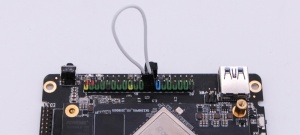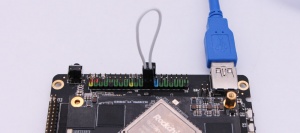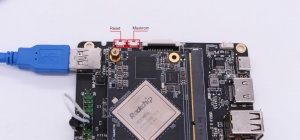Difference between revisions of "RockpiN10/dev/usb-install"
(→Boot the board to maskrom mode) |
(→Boot the board to maskrom mode) |
||
| Line 79: | Line 79: | ||
To boot ROCK Pi N10 into maskrom mode is simple since we have the maskrom key on board. | To boot ROCK Pi N10 into maskrom mode is simple since we have the maskrom key on board. | ||
| − | * Power off the board and '''remove any bootable storage media''' such as microSD card. If you have bootloader in SPI flash, you need to shortcut SPI flash first as picture below. Or you can erase SPI at first. | + | * Power off the board and '''remove any bootable storage media''' such as microSD card. If you have bootloader in SPI flash, you need to shortcut SPI flash first as picture below. Or you can erase SPI flash at first. |
[[File:Rockpin10_spi_shortcut.jpeg | 300px ]](click to view large image) | [[File:Rockpin10_spi_shortcut.jpeg | 300px ]](click to view large image) | ||
Revision as of 06:41, 25 April 2020
ROCK Pi N10 > Development > Install from USB OTG
ROCK Pi N10 comes with on board eMMC, you can install images to eMMC with USB. The installation is running in maskrom mode, which is a special running mode the CPU is waiting for command from USB OTG port. The PC tool we use to communicate with ROCK Pi in maskrom mode is rkdevelop tool, an open source tool by Rockchip.
Contents
Requirement
- ROCK Pi N10 main board
- Power adapter
- USB Male A to Male A cable(important) USB-C has been seen as not working, an adaptor for USB-C to USB-A has worked. See discussion.
Make sure rkdeveloptool is set up on host computer
Linux
To build rkdeveloptool on a debain based Linux distribution, follow the instruction below:
Install build dependecy:
sudo apt-get install libudev-dev libusb-1.0-0-dev dh-autoreconf
Clone the source code and build:
git clone https://github.com/rockchip-linux/rkdeveloptool cd rkdeveloptool autoreconf -i ./configure make
If you encounter compile error like below
./configure: line 4269: syntax error near unexpected token `LIBUSB1,libusb-1.0' ./configure: line 4269: `PKG_CHECK_MODULES(LIBUSB1,libusb-1.0)'
You should install pkg-config libusb-1.0
sudo apt-get install pkg-config libusb-1.0
Then re-run
autoreconf -i ./configure make
Now you have rkdeveloptool executable at the current directory.
sudo cp rkdeveloptool /usr/local/bin/
MacOS
To build rkdeveloptool on macOS, you need homebrew(or similar package manager) to install required packages.
Install build dependency:
brew install automake autoconf libusb
Clone the source code and build:
git clone https://github.com/rockchip-linux/rkdeveloptool cd rkdeveloptool autoreconf -i ./configure make
If you encounter compile error like below
./configure: line 4269: syntax error near unexpected token `LIBUSB1,libusb-1.0' ./configure: line 4269: `PKG_CHECK_MODULES(LIBUSB1,libusb-1.0)'
You should install pkg-config libusb-1.0
brew install pkg-config
Then re-run
autoreconf -i ./configure make
Now you have rkdeveloptool executable at the current directory.
sudo cp rkdeveloptool /usr/local/bin/
Boot the board to maskrom mode
To boot ROCK Pi N10 into maskrom mode is simple since we have the maskrom key on board.
- Power off the board and remove any bootable storage media such as microSD card. If you have bootloader in SPI flash, you need to shortcut SPI flash first as picture below. Or you can erase SPI flash at first.
- Plug the USB Male A to Mail A cable to ROCK Pi N10 OTG port(the front USB3 port), the other side to PC
- Power on the board
- Press and hold the maskrom key, short press the reset key
- Release the maskrom key
Now on your Linux PC, lsusb command show show the following usb devices
Bus 003 Device 005: ID 2207:330c
It means the device is in maskrom mode now.
- Now plug the eMMC module and proceed the next step to flash.
Install to eMMC via USB
On your PC, run the rkdeveloptool
rkdeveloptool ld # List the device DevNo=1 Vid=0x2207,Pid=0x330c,LocationID=305 Maskrom
Download the loader (flash helper) to init the ram and prepare the flashing environment etc. If you don't have it, you can download it from here
rkdeveloptool db rk3399pro_loader_3GB_ddr_v1.22.115.bin # For ROCK Pi N10 Model A rkdeveloptool db rk3399pro_loader_vxxxx.bin # For ROCK Pi N10 Model B/C
Write the GPT image to eMMC, start to write from offset 0.
rkdeveloptool wl 0 /path/to/rockpin10xxx-gpt.img
Reboot the device
rkdeveloptool rd
Now the device should boot the new image on eMMC
Install by partitions(optional)
Sometimes we only want to update a partition of the image, for example only the boot partition to update kernel only. We can flash by partitions
| Part Number | Offset | Name | Description |
|---|---|---|---|
| raw | 32KB | loader1 | First stage loader |
| raw | 8MB | loader2 | U-boot image |
| raw | 12MB | trust | ATF |
| 1 | 16MB | boot | Kernel partition, bootable |
| 2 | 528MB | rootfs | Rootfs |
When the board is in maskrom mode, flash the partitions with the following command and offset:
rkdeveloptool db rk3399pro_loader_*.bin rkdeveloptool wl 64 idbloader.img rkdeveloptool wl 16384 uboot.img rkdeveloptool wl 24576 trust.img rkdeveloptool wl 32768 boot.img rkdeveloptool wl 1081344 rootfs.img
Troubleshooting
- If you have issue with flashing via USB OTG, start a new post on the forum. https://forum.radxa.com/c/dev



